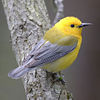Piciformes
| Piciformes | ||||||||||||||
|---|---|---|---|---|---|---|---|---|---|---|---|---|---|---|
Male Red-bellied Woodpecker,
(Melanerpes carolinus) |
||||||||||||||
| Scientific classification | ||||||||||||||
|
||||||||||||||
| Suborders and families | ||||||||||||||
|
Galbulae
Pici
For prehistoric taxa, see text |
||||||||||||||
| Synonyms | ||||||||||||||
|
Galbuliformes |
Six families of largely arboreal birds make up the order Piciformes, the best-known of them being the Picidae, which includes the woodpeckers and close relatives. The Piciformes contain about 67 living genera with a little over 400 species, of which the Picidae (woodpeckers and relatives) make up about half.
In general, the Piciformes are insectivorous, although the barbets and toucans mostly eat fruit and the honeyguides are quite unique among birds in being able to digest beeswax (their main foods is insects however). Nearly all Piciformes have parrot-like zygodactyl feet - two toes forward and two back, an arrangement that has obvious advantages for birds that spend much of their time on tree trunks. An exception are a few species of three-toed woodpeckers. The jacamars aside, Piciformes do not have down feathers at any age, only true feathers. They range in size from the Rufous Piculet at 8 centimetres in length, and weighing 7 grams, to the Black-mandibled Toucan, at 61 centimetres long, and weighing 500 grams[1]. All nest in cavities and have altricial young.
Contents |
Systematics and evolution
The Galbulidae and Bucconidae are often separated into a distinct Galbuliformes order. Analysis of nuclear genes confirms that they form a lineage of their own, but suggests that they are better treated as a suborder. The other families form another monophyletic group of suborder rank, but the barbets were determined to be paraphyletic with regard to the toucans and hence, the formerly all-encompassing Capitonidae have been split up. The woodpeckers and honeyguides are each other's closest relatives[2]
Reconstruction of the evolutionary history of the Piciformes has been hampered by poor understanding of the evolution of the zygodactyl foot. A number of prehistoric families and genera, from the Early Eocene Neanis and Hassiavis, the Zygodactylidae, Primoscenidae and "Homalopus"[3], to the Miocene "Picus" gaudryi and the Pliocene Bathoceleus are sometimes tentatively assigned to this order[4]. There are some extinct ancestral piciforms are known from fossils which have been notoriously difficult to place but at least in part probably belong to the Pici. The modern families are known to exist since the mid-late Oligo- to Early Miocene; consequently, the older forms appear to be more basal. It is interesting to note that a large part of piciform evolution seems to have occurred in Europe where only Picidae occur today; perhaps even some now exclusively Neotropical families have their origin in the Old World.
Familes
ORDER: PICIFORMES
- Unassigned (all fossil)
- Piciformes gen. et sp. indet. IRScNB Av 65 (Early Oligocene of Boutersem, Belgium)
- Piciformes gen. et sp. indet. SMF Av 429 (Late Oligocene of Herrlingen, Germany)
- Suborder Galbulae
- Family: Galbulidae - jacamars (18 species)
- Family: Bucconidae - puffbirds, nunbirds and nunlets (some 30 species)
- Suborder Pici
- Unresolved and basal taxa (all fossil)
- Family: Lybiidae - African barbets (about 40 species, recently split form Capitonidae)
- Family: Megalaimidae - Asian barbets (about 25 species, recently split form Capitonidae)
- Family: Ramphastidae - toucans (about 40 species)
- Family: Semnornithidae - toucan-barbets (2 species, recently split form Capitonidae)
- Family: Capitonidae - American barbets (about 15 species)
- Family: Miopiconidae (fossil)
- Family: Picidae - woodpeckers, piculets and wrynecks (over 200 species)
- Family: Indicatoridae - honeyguides (17 species)
Footnotes
- ↑ Short, Lester L. (1991). Forshaw, Joseph. ed.. Encyclopaedia of Animals: Birds. London: Merehurst Press. pp. 152-157. ISBN 1-85391-186-0.
- ↑ Johansson & Ericson (2003)
- ↑ Described in 1870, its name is preoccupied by a subgenus of Cryptocephalus leaf beetles described in 1835.
- ↑ Cracraft & Morony (1969)
- ↑ ramphastid?
- ↑ ramphastid? "capitonid" (Lybiidae, Megalaimidae)? own family Capitonididae?
- ↑ "capitonid" (Lybiidae, Megalaimidae)?
- ↑ "CMC 152", a distal carpometacarpus; more similar to extant barbets than to Capitonides: Ballmann (1969)
References
- Ballmann, Peter (1969): Les Oiseaux miocènes de la Grive-Saint-Alban (Isère) [The Miocene birds of Grive-Saint-Alban (Isère)]. Geobios 2: 157-204. [French with English abstract] doi:10.1016/S0016-6995(69)80005-7 (HTML abstract)
- Cracraft, Joel & Morony, John J. Jr. (1969): A new Pliocene woodpecker, with comments on the fossil Picidae. American Museum Novitates 2400: 1-8. PDF fulltext
- Gorman, Gerard (2004): Woodpeckers of Europe: A Study of the European Picidae. Bruce Coleman, UK. ISBN 1 872842 05 4.
- Johansson, Ulf S. & Ericson, Per G.P. (2003): Molecular support for a sister group relationship between Pici and Galbulae (Piciformes sensu Wetmore 1960). J. Avian Biol. 34(2): 185–197. doi:10.1034/j.1600-048X.2003.03103.x PDF fulltext
External links
|
||||||||||||||||||||||||||
